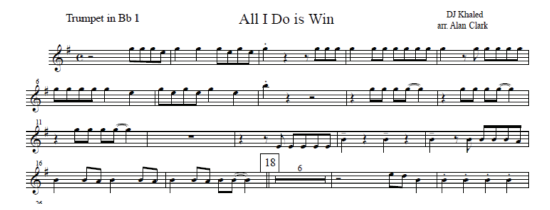1.3: Music Notation
- Page ID
- 54317
Music notation is any visual system (written or printed or rendered digitally on a screen) that is used to indicate the pitches and rhythms of a piece of music. Therefore, notation allows a composer to write down ideas for songs or concertos or symphonies and, also, allows that music to be spread through space and time. The development of music notation was absolutely critical to the rise of music that used more than just one melody. Everything that has developed in Western music after 1040 CE—from music of many independent voices (polyphonic) to solo voices with keyboard or group accompaniments, to the popular music we enjoy today—grew from this development. Though modern scholars have found examples of written musical symbols as far back as 900 CE, the staff notation system developed by Guido of Arezzo and others who followed him allowed for the accurate preservation and distribution of music. Music notation also greatly contributed to the growth, development, and evolution of the many musical styles over the past one thousand years.
Because of his contributions to the development of music notation, Guido of Arezzo is arguably the most important figure in the development of written music in the Western world. He developed a system of lines and spaces that enabled musicians to notate the specific notes in a melody. The development of music notation made it possible for composers to notate their music accurately, allowing others to perform the music exactly the way each composer intended. This ability allowed polyphonic (many-voiced) music to evolve rapidly after 1040 CE. The video linked below is an excellent resource that explains Guido’s contributions in more detail.
Ex. 1.1: Guido of Arezzo
http://www.youtube.com/watch?v=LxkstaYPztM
In the 1400s, the staff evolved into a five-line/four-space system that we still use today. This is an example of Guido's "Do Re Mi" written with modern staff and notation

Figure \(\PageIndex{1}\): Ut queant laxis or Hymnus in Ioannem is a Latin hymn in honor of John the Baptist Source: Matthew Thibeault after Guido of Arezzo Public Domain via Wikipedia
The popularity of staff notation grew quickly after Guido paved the way for the development of a method to notate rhythm. The system of rhythmic notation we use today in Western music has evolved over many years.
Ex. 1.2: Rhythm Notation - The basics of reading music
The following college marching band arrangement is adapted from DJ Khaled’s popular tune “All I Do is Win,” which shows an example of modern notation and rhythmic writing.



